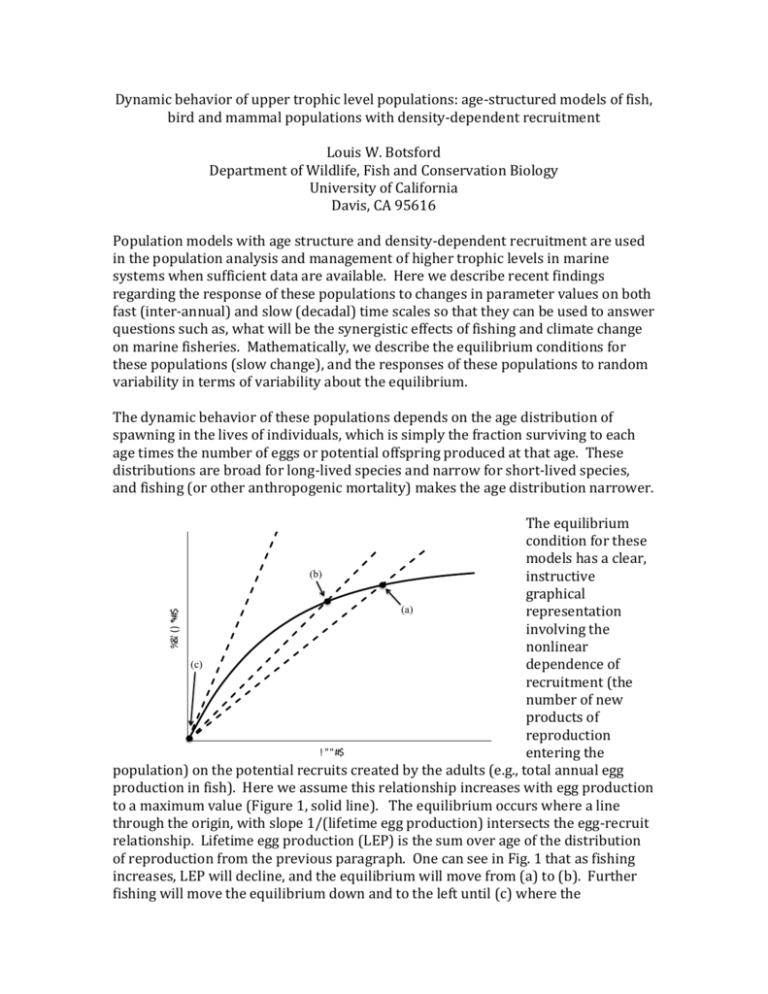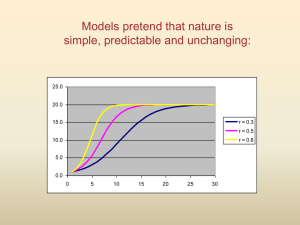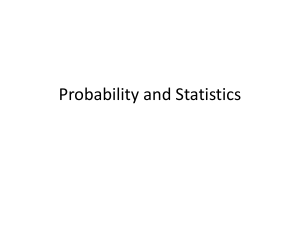Botsford_ForEcoInd - PICES WG27 North Pacific Climate
advertisement

Dynamic behavior of upper trophic level populations: age-structured models of fish, bird and mammal populations with density-dependent recruitment Louis W. Botsford Department of Wildlife, Fish and Conservation Biology University of California Davis, CA 95616 Population models with age structure and density-dependent recruitment are used in the population analysis and management of higher trophic levels in marine systems when sufficient data are available. Here we describe recent findings regarding the response of these populations to changes in parameter values on both fast (inter-annual) and slow (decadal) time scales so that they can be used to answer questions such as, what will be the synergistic effects of fishing and climate change on marine fisheries. Mathematically, we describe the equilibrium conditions for these populations (slow change), and the responses of these populations to random variability in terms of variability about the equilibrium. The dynamic behavior of these populations depends on the age distribution of spawning in the lives of individuals, which is simply the fraction surviving to each age times the number of eggs or potential offspring produced at that age. These distributions are broad for long-lived species and narrow for short-lived species, and fishing (or other anthropogenic mortality) makes the age distribution narrower. %&' () *+#$ The equilibrium condition for these models has a clear, (b) instructive graphical (a) representation involving the nonlinear (c) dependence of recruitment (the number of new products of reproduction ! ""#$ entering the population) on the potential recruits created by the adults (e.g., total annual egg production in fish). Here we assume this relationship increases with egg production to a maximum value (Figure 1, solid line). The equilibrium occurs where a line through the origin, with slope 1/(lifetime egg production) intersects the egg-recruit relationship. Lifetime egg production (LEP) is the sum over age of the distribution of reproduction from the previous paragraph. One can see in Fig. 1 that as fishing increases, LEP will decline, and the equilibrium will move from (a) to (b). Further fishing will move the equilibrium down and to the left until (c) where the equilibrium equals zero (i.e., the population will collapse). The way in which this population equilibrium responds to fishing depends on the distribution of spawning over age, which depends on survival and fecundity vs. age, both of which could change with climate (slow time scale). Inter-annual population variability is typically caused by inter-annual variability in survival or fecundity at age, or inter-annual variability in development rate. Variable survival and fecundity vary the magnitude of the spawning age distribution, while variable development moves it back and forth between younger (fast development) and older (slow development) age. The resulting population variability can be observed in a time series of recruitment, egg production or catch. The magnitudes of variability differ among these, but variability is generally becomes greater as the slope at equilibrium of the egg-recruit function becomes greater, i.e., as with fishing (Fig. 2a, b). This is the mechanism by which fishing a population not only reduces recruitment and abundance, but also makes the population more sensitive to environmental variability. Changes in the shape of the spawning age distribution, either through fishing or slow change in survival, fecundity or development rate also change the relative sensitivity of a population to the frequencies of variability in the environment. The bottom part of Fig. 2 illustrates the mechanism by which since the abundance at each age depends on past values of recruitment, hence egg production forms a positive feed-back of past values of recruitment on itself. In this mechanism, the narrower the distribution of lags is, the greater the tendency is for the system to resonate at a period equal to the mean lag, i.e., the generation time. Thus populations are more sensitive to environmental variability on generational time scales, more sensitive with narrower spawning age distributions, and less sensitive with broader spawning age distributions. Populations are also more sensitive to environmental variability on very slow time scales. Figure 2. Schematic view of equilibrium and variability when unfished (a) and fished (b).







